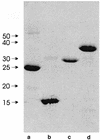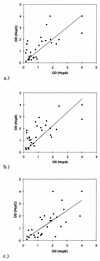Detection of high titers of antibody against Helicobacter cysteine-rich proteins A, B, C, and E in Helicobacter pylori-infected individuals
- PMID: 12853383
- PMCID: PMC164274
- DOI: 10.1128/cdli.10.4.542-545.2003
Detection of high titers of antibody against Helicobacter cysteine-rich proteins A, B, C, and E in Helicobacter pylori-infected individuals
Abstract
The family of Helicobacter cysteine-rich proteins (Hcp) constitutes one of the largest protein families that are specific for proteobacteria from the delta/epsilon subgroup. Most of the proteins belonging to this family have so far only been recognized on the genome level. To investigate the expression of Hcp proteins in vivo we analyzed titers of antibody against HcpA (HP0211), HcpB (HP0336), HcpC (HP1098), and HcpE (HP0235) in sera from 30 Helicobacter pylori-positive individuals and in a control group of six H. pylori-negative individuals. Significantly higher titers of antibody were observed for H. pylori-positive individuals (P < 0.00005). The highest and lowest titers were observed for HcpC (Delta mean = 1.06) and HcpB (Delta mean = 0.333), respectively. There is a clear correlation among anti-HcpA, -HcpC, and -HcpE immunoglobulin G titers in H. pylori-positive individuals (correlation > 0.7), but there is only a weak correlation for HcpB (correlation < 0.4). These results confirm that Hcp proteins are expressed by H. pylori under natural environmental conditions and that these proteins are recognized by the immune system of the host. The observed correlations are in agreement with the expected distribution of Hcp proteins among H. pylori strains. HcpA, HcpC, and HcpE are present in the genomes of strains 26695 and J99, whereas HcpB is absent from most strains. Since Hcp proteins are specific for H. pylori, immunological assays including Hcp proteins might be of value to detect H. pylori infection and perhaps to distinguish among different groups of H. pylori-positive patients.
Figures


Similar articles
-
Human antibody response to Helicobacter pylori lipopolysaccharide: presence of an immunodominant epitope in the polysaccharide chain of lipopolysaccharide.Infect Immun. 1998 Jun;66(6):3006-11. doi: 10.1128/IAI.66.6.3006-3011.1998. Infect Immun. 1998. PMID: 9596783 Free PMC article.
-
Immune responses to Helicobacter pylori infection in children with intellectual disabilities.Res Dev Disabil. 2012 Mar-Apr;33(2):663-9. doi: 10.1016/j.ridd.2011.11.010. Epub 2011 Dec 18. Res Dev Disabil. 2012. PMID: 22186633
-
Helicobacter pylori recombinant UreG protein: cloning, expression, and assessment of its seroreactivity.BMC Res Notes. 2014 Nov 18;7:809. doi: 10.1186/1756-0500-7-809. BMC Res Notes. 2014. PMID: 25406411 Free PMC article.
-
Frequencies of the expression of main protein antigens from Helicobacter pylori isolates and production of specific serum antibodies in infected patients.World J Gastroenterol. 2005 Jan 21;11(3):421-5. doi: 10.3748/wjg.v11.i3.421. World J Gastroenterol. 2005. PMID: 15637759 Free PMC article.
-
Helicobacter pylori Eradication in Patients with Immune Thrombocytopenic Purpura: A Review and the Role of Biogeography.Helicobacter. 2015 Aug;20(4):239-51. doi: 10.1111/hel.12200. Epub 2015 Mar 1. Helicobacter. 2015. PMID: 25728540 Free PMC article. Review.
Cited by
-
Structural and functional aspects of the Helicobacter pylori secretome.World J Gastroenterol. 2014 Feb 14;20(6):1402-23. doi: 10.3748/wjg.v20.i6.1402. World J Gastroenterol. 2014. PMID: 24587618 Free PMC article. Review.
-
How Long Will It Take to Launch an Effective Helicobacter pylori Vaccine for Humans?Infect Drug Resist. 2023 Jun 15;16:3787-3805. doi: 10.2147/IDR.S412361. eCollection 2023. Infect Drug Resist. 2023. PMID: 37342435 Free PMC article. Review.
-
Novel therapeutic regimens against Helicobacter pylori: an updated systematic review.Front Microbiol. 2024 Jun 7;15:1418129. doi: 10.3389/fmicb.2024.1418129. eCollection 2024. Front Microbiol. 2024. PMID: 38912349 Free PMC article. Review.
-
Characterization of the Helicobacter pylori cysteine-rich protein A as a T-helper cell type 1 polarizing agent.Infect Immun. 2005 Aug;73(8):4732-42. doi: 10.1128/IAI.73.8.4732-4742.2005. Infect Immun. 2005. PMID: 16040986 Free PMC article.
-
Recognition of host proteins by Helicobacter cysteine-rich protein C.Curr Microbiol. 2011 Sep;63(3):239-49. doi: 10.1007/s00284-011-9969-2. Epub 2011 Jul 7. Curr Microbiol. 2011. PMID: 21735226
References
-
- Alm, R. A., L. S. Ling, D. T. Moir, B. L. King, E. D. Brown, P. C. Doig, D. R. Smith, B. Noonan, B. C. Guild, B. L. deJonge, G. Carmel, P. J. Tummino, A. Caruso, M. Uria-Nickelsen, D. M. Mills, C. Ives, R. Gibson, D. Merberg, S. D. Mills, Q. Jiang, D. E. Taylor, G. F. Vovis, and T. J. Trust. 1999. Genomic-sequence comparison of two unrelated isolates of the human gastric pathogen Helicobacter pylori. Nature 397:176-180. - PubMed
-
- Chanto, G., A. Occhialini, N. Gras, R. A. Alm, F. Megraud, and A. Marais. 2002. Identification of strain-specific genes located outside the plasticity zone in nine clinical isolates of Helicobacter pylori. Microbiology 148:3671-3680. - PubMed
-
- Dunn, B. E., G. P. Campbell, G. I. Perez-Perez, and M. J. Blaser. 1990. Purification and characterization of urease from Helicobacter pylori. J. Biol. Chem. 265:9464-9469. - PubMed
Publication types
MeSH terms
Substances
LinkOut - more resources
Full Text Sources
Medical
Miscellaneous

